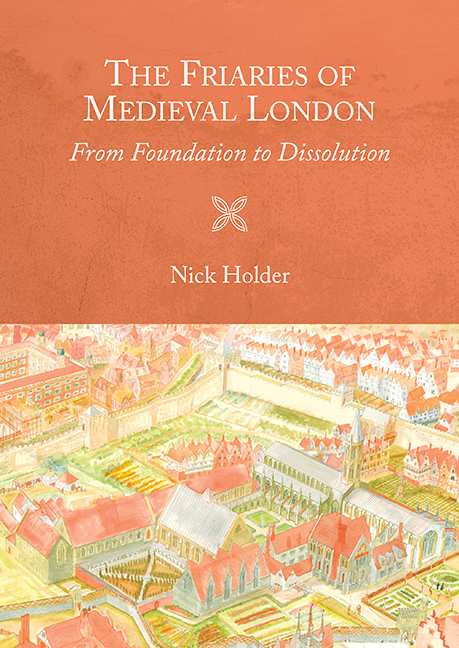Book contents
- Frontmatter
- Contents
- List of Illustrations and Tables
- Contributors
- Acknowledgements
- Abbreviations
- Introduction
- Part I The Nine London Friaries
- 1 The First Black Friars in Holborn, c. 1223–86
- 2 The Second Black Friars, 1275–1538
- 3 The Third Black Friars at St Bartholomew's, 1556–9
- 4 Grey Friars, 1225–1538
- 5 White Friars, c. 1247–1538
- 6 Austin Friars, c. 1265–1538
- 7 Crossed Friars, c. 1268–1538
- 8 Sack Friars, c. 1270–1305
- 9 Pied Friars, 1267–1317
- Part II The London Friars and their Friaries
- Conclusions
- Timeline
- Bibliography
- Index
- Miscellaneous Endmatter
4 - Grey Friars, 1225–1538
from Part I - The Nine London Friaries
Published online by Cambridge University Press: 16 May 2018
- Frontmatter
- Contents
- List of Illustrations and Tables
- Contributors
- Acknowledgements
- Abbreviations
- Introduction
- Part I The Nine London Friaries
- 1 The First Black Friars in Holborn, c. 1223–86
- 2 The Second Black Friars, 1275–1538
- 3 The Third Black Friars at St Bartholomew's, 1556–9
- 4 Grey Friars, 1225–1538
- 5 White Friars, c. 1247–1538
- 6 Austin Friars, c. 1265–1538
- 7 Crossed Friars, c. 1268–1538
- 8 Sack Friars, c. 1270–1305
- 9 Pied Friars, 1267–1317
- Part II The London Friars and their Friaries
- Conclusions
- Timeline
- Bibliography
- Index
- Miscellaneous Endmatter
Summary
IN the first decade of the thirteenth century a young man in his twenties called Giovanni, the son of a wealthy Italian silk merchant, Pietro di Bernardone, renounced military service, his friends, his family and even his inheritance. Under his family name of Francesco and with a toponymic surname recording the Umbrian town of his upbringing, Francis of Assisi began a career of simple popular preaching. Recognised by Pope Innocent III in 1210 and in 1215, and with a Rule approved by Honorius III in 1223, Francis’ informal group of poor itinerant preachers quickly grew into an international religious order. Francis termed his preachers fratres minores, lesser brothers, with the term ‘minor’ alluding to an exhortation to poverty and humility in the Rule: et sint minores – ‘let [the friars] be the lowest’. The first Franciscans – a party of nine – arrived in England in September 1224, during the lifetime of their founder. Four of them quickly made their way to London, staying initially with the newly established Dominicans and then at a house in Cornhill. The following year they moved to newly granted premises in the parish of St Nicholas Shambles, near Newgate in the west of the city. In England the friars quickly became known as Grey friars, a reference to the colour of their hooded woollen habits or cowls.
The numbers of London Franciscans quickly increased from that first group of the 1220s, reaching a peak of about ninety in the early fourteenth century. After this, numbers seem to have declined for the rest of the house's existence, with fewer than fifty residents by the late fourteenth century and thirty-five in 1460 (including the guardian and provincial prior). Twenty-seven friars remained in 1538 to sign the dissolution agreement. Of all the London mendicants, the Franciscans had the least secure finances and the greatest reliance on alms: they had a church and buildings second only to the Dominicans in terms of grandeur and extent, but they lacked their counterparts’ regular royal income and large rental portfolio. They would have struggled to meet the annual living costs of some £50, just for feeding the friars, let alone paying for servants, repairs and the house's contribution to the province and prior general in Rome.
- Type
- Chapter
- Information
- The Friaries of Medieval LondonFrom Foundation to Dissolution, pp. 66 - 96Publisher: Boydell & BrewerPrint publication year: 2017

